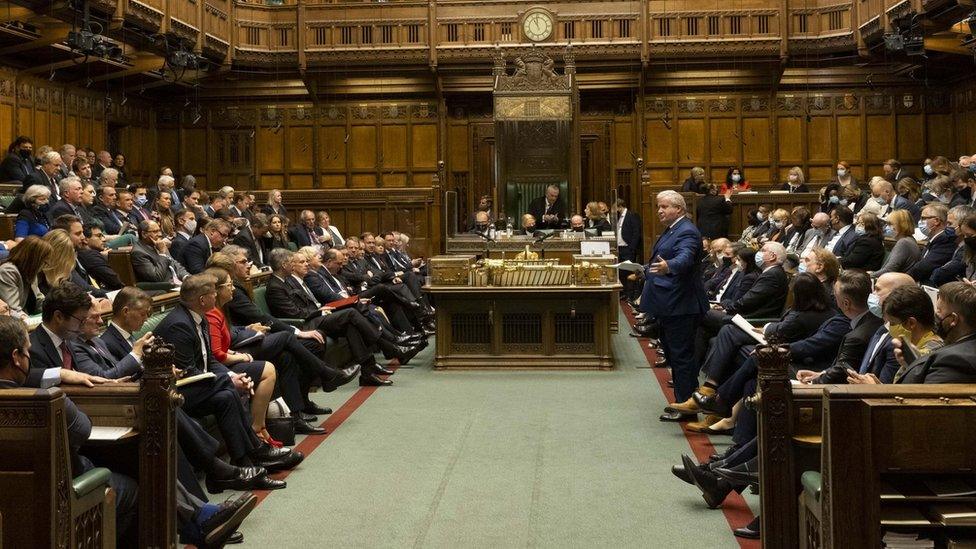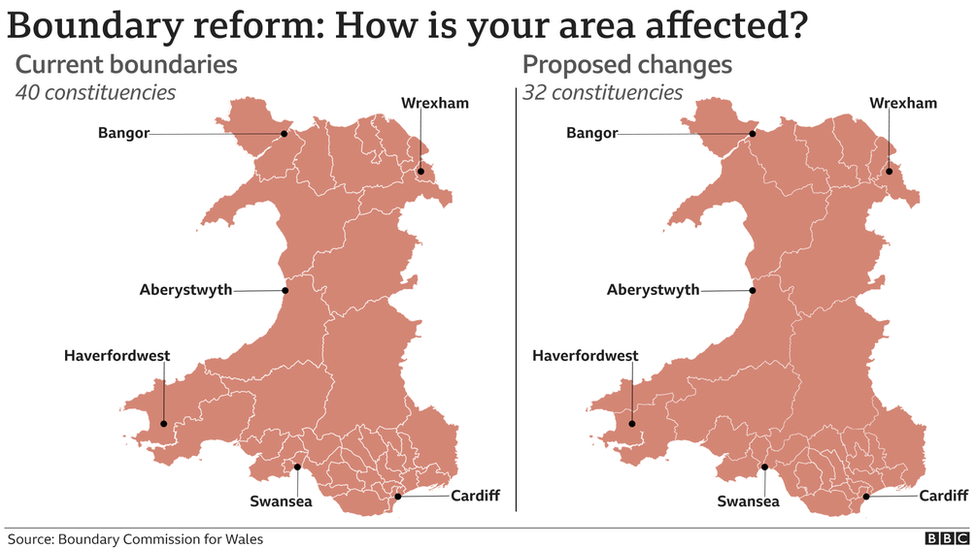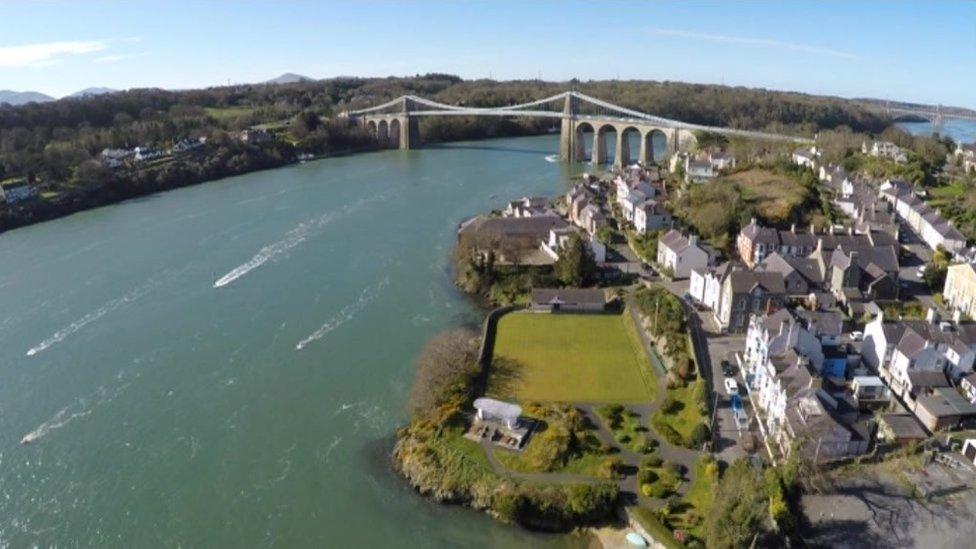Major changes to cut number of Welsh MPs published
- Published
- comments

Wales is due to have eight fewer MPs at the next general election, dropping from 40 to 32
Major proposals to change Wales' Westminster constituencies have been published, as the number of Welsh MPs drops from 40 to 32.
Arfon, which covers part of Gwynedd, could go and the number of north-east Wales MPs could drop from six to four.
Welsh Secretary Simon Hart could face a battle for his seat as Carmarthen West and South Pembrokeshire is redrawn.
The Boundary Commission for Wales' initial plans, external now enter an eight-week public consultation.
There will be two more separate consultations before final proposals are presented to MPs, with the final changes due to take effect at the next general election.
Plans to redraw the Parliamentary boundaries date back around a decade, when David Cameron was prime minister.
The Boundary Commission has no power to set the number of MPs - which has already been decided by Parliament - and will not consider arguments around the number of constituencies.
Under new Westminster rules each constituency proposed by the Boundary Commission for Wales must contain between 69,724 and 77,062 registered voters.
The UK government says, external this will ensure people from all parts of the United Kingdom have equal representation in Parliament.
The only exception to that rule will be Ynys Môn, which was given a "protected status" last year, meaning no changes to the Anglesey seat's name or boundaries - leaving it with 52,415 voters.
Every other constituency in Wales will see changes, with the majority changing names and some disappearing entirely by being absorbed into neighbouring constituencies.

One of the constituencies affected will be Carmarthen West and South Pembrokeshire, the seat held by UK government cabinet member Mr Hart.
The constituency, which has 58,048 registered voters, would be redrawn to include parts of the Preseli Pembrokeshire seat held by former Conservative Welsh Secretary Stephen Crabb and would be rebranded Mid and South Pembrokeshire, along with a new Ceredigion Preseli seat.
Speaking to journalists on Wednesday, Mr Hart said the boundary redrawing process had "years to run yet".
"This is the implementation of a manifesto commitment to make the parliamentary boundaries in Wales fairer for voters," he said.
"It's not about career prospects of individual MPs or good fortune for particular political parties, this is making sure that every vote in Wales is of the same value."
The former "red wall" seats of north-east Wales could also face cuts, with Clwyd South and Vale of Clwyd disappearing.
Clwyd South, a Conservative gain from Labour in the 2019 general election, would being split between Alyn and Deeside, Wrexham and a newly-named Montgomeryshire and Glyndwr constituency.
Another Tory gain in 2019, Vale of Clwyd, would also be absorbed by Clwyd and Delyn.

The Ynys Môn constituency is the only one in Wales to be untouched in the plan
Arfon, which has 43,215 voters, will be split between Dwyfor Meirionydd and Aberconwy - with Caernarfon in the former and Bangor in the latter.
The Bridgend seat, another Conservative gain at the last election, would be split between a new constituency called Aberafan Porthcawl and a new Bridgend seat that would include parts of the current Ogmore constituency.
How were these plans decided?
The Boundary Commission said it considered several factors in developing its proposals, from geography to local and historical ties, as well as the required number of voters.
Secretary to the Boundary Commission for Wales Shereen Williams said: "We've had to propose significant changes due to the reduction in the number of Welsh constituencies and that's presented a particular challenge as we seek to develop a map which meets the conditions laid out in the (Parliamentary Constituencies) Act, but also meets the expectations of the people of Wales.
"We're confident that our proposals are a strong first attempt to create a workable map of 32 Welsh constituencies.
"The purpose of our initial proposals, however, is to start the conversation about how the new map will look."
What has the political reaction been?
Liz Saville Roberts, Plaid Cymru MP for Dwyfor Meirionnydd, said she thinks the move is "yet another argument that Wales should be taking over [its] own affairs".
"We just lose our voice," she told BBC Radio Wales Breakfast, adding she feared the proposals would make it even harder for MPs to serve their constituents.
"There are certain areas in here as [the map] stands that are so huge. If you live in certain parts of Wales you should be asking yourself: 'Am I getting fair service from my MP when I need them?'"
Meanwhile, Labour MP for Rhondda Chris Bryant said "it is a deliberate campaign by the Conservatives" to get people who typically vote against them to vote for them.
Mr Bryant also criticised the UK government's proposal to pass a law requiring people to show an approved form of identification in order to vote.
"Many people in my constituency and people who live in transient communities in cities who normally tend to vote labour are going to find it more difficult to register, vote and participate in democracy", he added.
But according to Sir John Curtice, professor of politics at the University of Strathclyde, "it's no longer clear whether the Conservatives will necessarily lose significantly less than Labour" in Wales after proposed boundary reform.
Related topics
- Islwyn
- Gower
- Wales
- Rhondda
- Preseli Pembrokeshire
- House of Commons
- Conwy
- Aberconwy
- Cardiff Central
- Llanelli
- Newport West
- Cardiff West
- Carmarthen East and Dinefwr
- Wrexham
- Caernarfon
- Brecon and Radnorshire
- Merthyr Tydfil
- UK government
- Arfon
- Cardiff South and Penarth
- Aberavon
- Cynon Valley
- Bridgend
- Newport
- Monmouth
- Clwyd South
- Newport East
- Montgomeryshire
- Monmouth
- Neath
- Wrexham
- Pontypridd
- Ogmore
- Delyn
- Bridgend
- Newport
- Ceredigion
- Ynys Mon
- Swansea West
- Neath
- Clwyd West
- Cardiff North
- Rhondda
- Carmarthen West and South Pembrokeshire
- Alyn and Deeside
- Ogmore
- Pontypridd
- Dwyfor Meirionnydd
- Torfaen
- Caerphilly
- Llanelli
- Merthyr